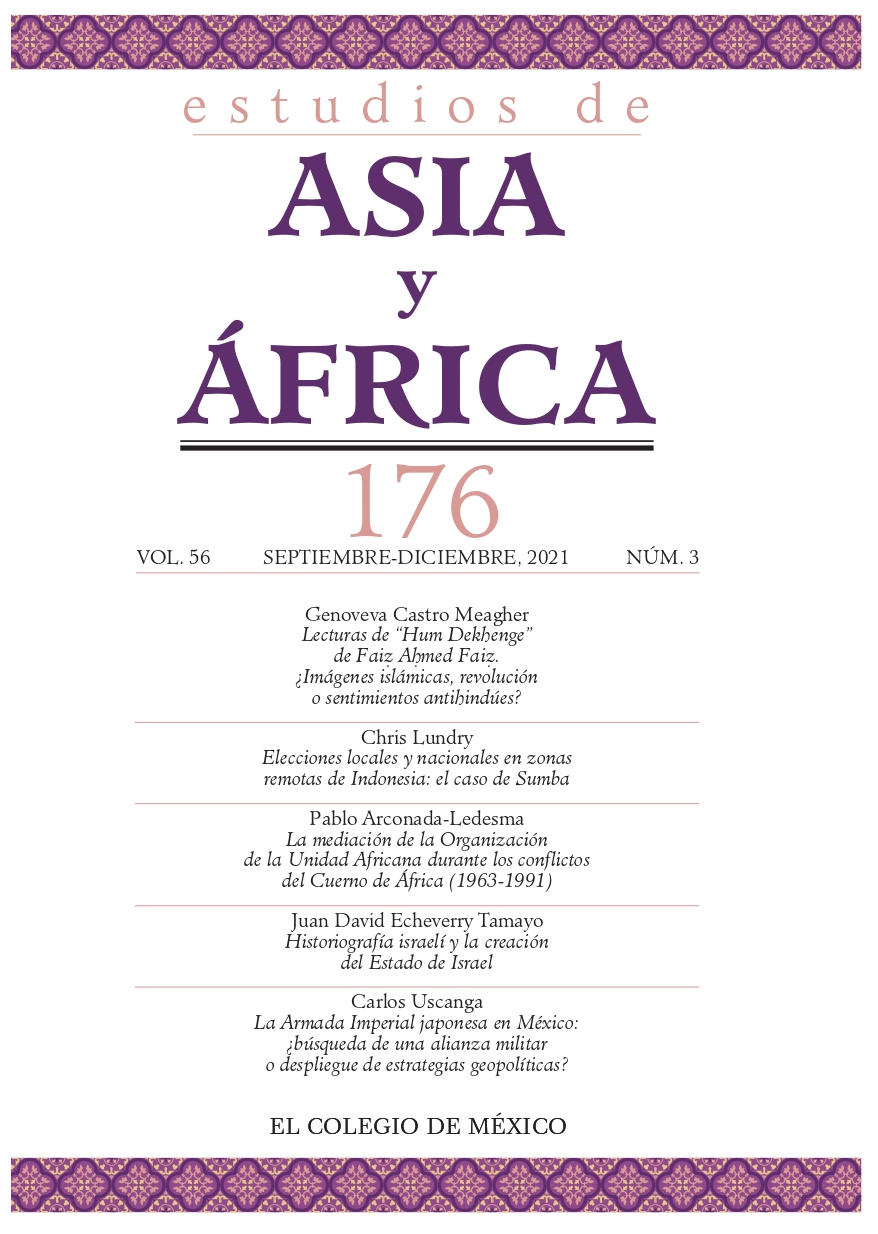Abstract
The nation, like any other system of human organization, must be understood as a discourse with a specific origin and not as an objective, teleological and primal phenomenon. In this sense, since a large influx of Jewish migrants came to Palestine to build a nationstate in this territory, Zionist and Israeli intellectuals and politicians have constructed subjective explanations to justify their demands and interests. These turned into historiographic paradigms that gave meaning to the Israeli population’s identity, culture, and links to the land. With this in mind, this study strikes a balance between the main historiographical trends that have defined the creation of the Israeli State. It seeks to clarify the Israel’s underlying ideology and to explore historiography’s adaptations at different junctures of the Israeli-Palestinian conflict.
References
Alkalay, Yehuda. 1865. ילגאר רשבמ. תרבוח דובכל תירבה תילארשי הלסרבינוא [Raglei Mevasser. Folleto en honor a Alliance Israélite Universelle]. Belgrado: n.d.
Anderson, Benedict. 1993. Comunidades imaginadas. Reflexiones sobre el origen y la difusión del nacionalismo. México: Fondo de Cultura Económica.
Ben-Sasson, Haim Hillel, ed. 1969. Toldot Am Israel [Historia del pueblo judío]. Vol. 1. Tel Aviv: Dvir.
Benvenisti, Meron. 2000. Sacred Landscape: The Buried History of the Holy Land since 1948. Berkeley: University of California Press.
Bohm, Adolf. 1920. Die Zionistische Bewegung [El movimiento sionista]. Vol. 1. Berlín: Welt.
Dershowitz, Alan. 2003. The Case for Israel. Hoboken: John Wiley & Sons.
Dubnow, Simón. 1939. Divrei Yemei ‘Am ‘Olam [La historia de un pueblo eterno]. Vols. 1-2. Tel Aviv: Dvir.
Gelber, Yoav. 2007. “The History of Zionist Historiography: From Apologetics to Denial”. En Making Israel, editado por Benny Morris, 47-80. Ann Arbor: University of Michigan Press.
Gelber, Yoav. 2011. Nation and History: Israeli Historiography Between Zionism and post-Zionism. Londres: Vallentine Mitchell.
Gijón Mendigutia, Mar. 2008. “Los ‘nuevos historiadores’ israelíes. Mitos fundacionales y desmitificación”. Revista de Estudios Internacionales Mediterráneos, núm. 5: 27-41.
Graetz, Heinrich. 1891. History of the Jews. Vols. 1-3. Filadelfia: The Jewish Publication Society of America.
Gruenbaum, Yitzhak. 1946. The History of Zionism. Part I: The Pre-Herzlian Period. Tel-Aviv: Lion the Printer for the Zionist Organization Youth Department.
Hess, Moses. 1918. Rome and Jerusalem. A Study in Jewish Nationalism. Nueva York: Bloch.
Kalisher, Zvi Hirsch. 1964. Drishat Zion [En búsqueda de Sion]. Jerusalén: Mossad Harav Kook.
Kolatt, Israel. 1976. “Heker toldot ha-Tziyonut ve-ha-yishuv” [Sobre la investigación de la historia del yishuv y el movimiento sionista]. En Al ha-mehkar ve-ha-hoker shel toldot ha-yishuv ve-ha-Tziyonut [Sobre la investigación y el investigador de la historia del yishuv y el movimiento sionista], Catedra 1. Jerusalén: HaUniversita.
Krell, Yehuda. 2014. Páginas de odio. Historia del antisemitismo. Buenos Aires: Dunken.
Kuhn, Thomas S. 2004. La estructura de las revoluciones científicas. Traducido por Carlos Solís Santos. México: Fondo de Cultura Económica.
Lewis, Bernard. n.d. “1834-1892-Primeras ideas y actuaciones sionistas: Alkalai, Hess, Kalisjer, Eliot, Pinsker, Bodenheimer…”. https://sites.google.com/site/misjuderias/israel/historia/1840-1917---moderna-ideacion-y-gestacion-del-estado-de-israel/1840---primeras-ideas-y-actuaciones-sionistas
Lichtheim, Richard. 1951. Toldot ha-Tziyonit be-Germania [Historia del sionismo en Alemania]. Jerusalén: The Sionist Library.
Liebel, Helen. P. 1971. “The Enlightenment and the Rise of Historicism in German Thought”. Eighteenth-Century Studies 4(4): 359-385. https://doi.org/10.2307/2737710
Lobo, Gregory J. 2009. Colombia: algo diferente de una nación. Bogotá: Universidad de los Andes.
MidEast Web. 2017. “La población árabe y judía en ‘Palestina’ durante el Imperio otomano y el Mandato británico. Consideraciones estadísticas y demográficas”. PorIsrael, 10 de julio de 2017. http://porisrael.org/2017/07/10/la-poblacion-arabe-y-judia-en-palestina-durante-el-imperio-otomano-y-el-mandato-britanico-consideraciones-estadisticas-y-demograficas/
Morocutti, Pietro. 2015. “Desde la lucha entre historiografías nacionales hacia la narración-puente; el caso de Palestina/Israel”. Miscelánea de Estudios Árabes y Hebraicos, Sección Árabe-Islam 64: 75-94.
Myers, David N. y David B. Ruderman, eds. 1998. The Jewish Past Revisited: Reflections on Modern Jewish Historians. New Haven, CT: Yale University Press.
Neuberger, Benyamin. 1999. “Zionism”. Israel Ministry of Foreign Affairs. https://mfa.gov.il/MFA/AboutIsrael/State/Pages/ZIONISM-%20Background.aspx
Pappé, Ilan. 2008. “Zionism as Colonialism: A Comparative View of Diluted Colonialism in Asia and Africa”. South Atlantic Quarterly 107(4): 611-633.
Pérez González, Carmen y Pedro Sánchez Herráez. 2012. El conflicto palestino israelí II. Madrid: Ministerio de Defensa.
Poblete Piedrabuena, Miguel Ángel y Carlos Javier Pardo Abad. 1989. “Los modelos de colonización agrícola israelíes: el kibutz y el moshav”. Ería: Revista Cuatrimestral de Geografía, núm. 19- 20: 202-207.
Ramos Tolosa, Jorge. 2014. “‘Un país de desolación, sílices y cenizas’. El mito de Palestina como tierra virgen en el discurso sionista”. Historia Social 78: 117-134.
Sánchez Aroca, Izaskun. 2010. “¿Una tierra sin pueblo, para un pueblo sin tierra?”. https://revistasoberaniaalimentaria.wordpress.com/2010/08/23/¿una-tierra-sin-pueblo-para-un-pueblo-sin-tierra/
Sand, Shlomo. 2013. La invención de la tierra de Israel: de Tierra Santa a madre patria. Madrid: Akal.
Silber, Michael K. 2008. “Alliance of the Hebrews, 1863-1875: The Diaspora Roots of an ultra-Orthodox proto-Zionist Utopia in Palestine”. The Journal of Israeli History. Politics, Society, Culture 27(2): 119-147. https://doi.org/10.1080/13531040802284031
Sokolow, Nahum. 1919. History of Zionism. Vol. 1. Londres: Longmans, Green & Co.
Torres Prieto, Juana María. 2009. “Retórica y argumentación en la literatura polémica cristiana de los siglos II-V”. Mainake 31: 271-280.
This work is licensed under a Creative Commons Attribution-NonCommercial-NoDerivatives 4.0 International License
Copyright 2022 Estudios de Asia y África



